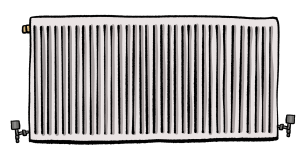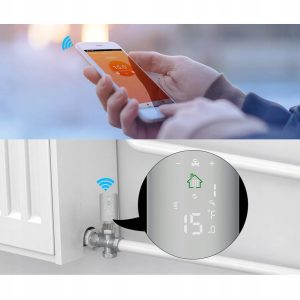Niegdyś zmianę temperatury w pomieszczeniu regulowano otwieraniem okien lub „dokładaniem” do pieca. Dzisiejszy postęp technologiczny pozwala na pełną automatyzację. Sterowanie ogrzewaniem nie tylko podnosi komfort użytkowników, ale może również znacząco obniżyć koszty utrzymania budynku.
Inteligentne sterowanie ogrzewaniem – co oznacza?
Sterowanie strefowe dotyczy każdego pomieszczenia z osobna. We wszystkich strefach mamy określoną indywidualnie temperaturę. Na przykład, w sypialni, strefie nocnej programujemy niższą temperaturę, a w łazience stałą. Istnieje możliwość ustawienia harmonogramów temperatur i zróżnicowania ich. Temperatura automatycznie jest regulowana według potrzeb i pory dnia. Użytkownicy instalacji zdecydowanie bardziej komfortowo spędzają wówczas czas w danym pomieszczeniu. A jeśli chcą nagle zmienić temperaturę otoczenia, wystarczy smartfon w dłoni z odpowiednią aplikacją. Sterowanie ogrzewaniem w inteligentnym budynku, to nic innego jak automatyczna regulacja temperatury.

Regulacja przepływów
Zmiana temperatury spowodowana jest regulacją przepływów. Nie należy ona do najłatwiejszych działań. Większość instalacji na rynku polskim ma problemy z precyzyjnym wyregulowaniem. Dodatkowo, nie jesteśmy w stanie sami spowodować, aby regulacja przepływów była tak precyzyjna, aby dostosować temperaturę do żądanego poziomu. Na pewno warto zamontować sterownik, który pozwoli na regulację temperatury o konkretnych porach w ciągu doby i tygodnia. Harmonogram poziomu ciepła można ustalać indywidualnie, dla każdego pomieszczenia osobno. Dzięki takiemu rozwiązaniu, można liczyć na konkretne oszczędności zużycia energii.
Gdzie sterowanie ogrzewaniem może mieć zastosowanie?
Zastosowanie automatycznego ogrzewania strefowego może mieć miejsce praktycznie w każdym budynku. Inteligentne ogrzewanie sprawdzi się zarówno przy instalacji elektrycznej, gazowej, podłogowej, grzejnikowej, mieszanej, jak i przy geotermalnych pompach ciepła. Elektroniczna głowica może z powodzeniem zastąpić tradycyjny termostat przy grzejniku. Głowica może działać bezprzewodowo lub przewodowo.

Jakie urządzenia pozwalają na regulację temperatury?
Do instalacji automatycznego sterowania ciepłem w budynku potrzebujemy:
- smartfona / tabletu / komputera z aplikacją HVAC
- łączności internetowej lub radiowej
- siłowników elektrycznych (tyle ile jest grzejników)
- elementów wykonawczych rozdzielni
- sterowników ściennych (tyle, ile jest pomieszczeń)
- okablowania magistralnego
Jak to działa?
Od regulatora temperatury przesyłany jest sygnał do grzejnika. W rezultacie otwiera się siłownik i ciepło zostaje przepuszczone. Podobnie, informacja o zwiększeniu temperatury może również być przekazana do sterownika pieca czy pompy ciepła. Co więcej, na aplikacji można kontrolować wysokość temperatury w poszczególnych pomieszczeniach, czy siłowniki są włączone/wyłączone oraz na czasowe działanie sterownika. Innymi słowy, zarządzamy ciepłem w pomieszczeniu przez jedno kliknięcie.
Sterowanie ogrzewaniem i problemy z nim związane
Podstawowym problemem przy instalacji automatycznego sterowania ogrzewania może być regulator pokojowy. Przychodzi on w standardzie, np. z kotłem gazowym. Pozostawiony na instalacji powoduje wówczas zamieszanie przez odłączenie całej instalacji od ogrzewania, na podstawie tylko jednego pomiaru temperatury. Inną przeszkodą podczas montażu może być nieprawidłowe okablowanie inwestycji. Kolejnym problemem może okazać się zainstalowanie belki rozdzielacza nieprzystosowanej do montaży np. siłowników termoelektrycznych.
Czy warto zainwestować w sterowanie ogrzewaniem?
Podsumowując, instalacja automatycznego ogrzewania zdecydowanie podnosi komfort użytkowników oraz obniża koszty z tym związane. Przy każdej inwestycji kosztorys związany z instalacją automatycznego ogrzewania przygotowywany jest indywidualnie. Wysokość nakładów finansowych zależy jednak od wielkości budynku, liczby sterowników oraz innych wymagań użytkowników. Dlatego warto umówić się z naszym ekspertem od smart home, który przedstawi możliwości inteligentnych rozwiązań w budynku, zaprojektuje instalację oraz przygotuje odpowiednio „skrojoną na miarę” ofertę.
